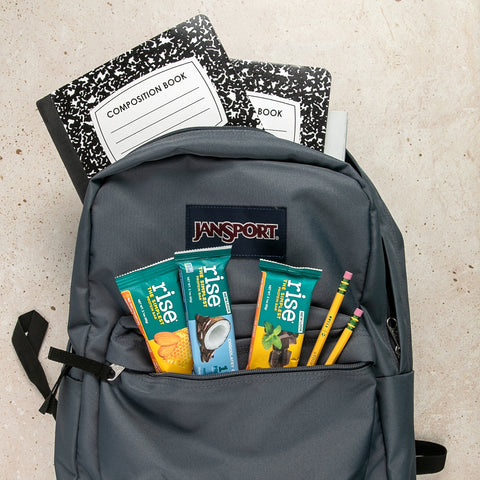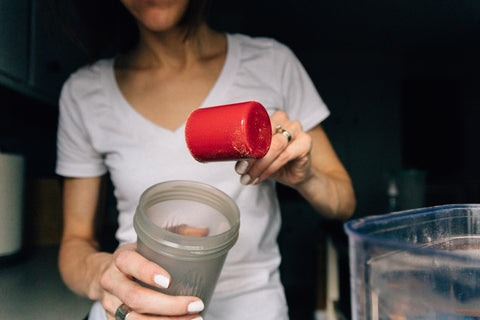Back-to-school season is equal parts exciting and overwhelming for parents and students alike.
You may be stressing about how you’ll get everyone out of summer mode and into early wakeups without losing your mind. Or you may be anxious about how to transition to remote learning or distance classes thanks to COVID-19.
No matter what you’re worried about, today’s guide has all the information you need to start the school year off on the right foot.
We’ll show you how to get organized and prepared to keep your health (and sanity!) in check.

How to Get Organized for a New School Year
The key to a stress-free back-to-school transition is becoming well-organized.
Follow these tips to create a system and stay sane whether you’re sending your kids off or leaving for college yourself:
Break Out the Planner to Create Your Game Plan
Like writing a grocery list before you go food shopping, you should come up with a game plan for your days, weeks, and months ahead.
This game plan will serve as the blueprint for all your responsibilities, commitments, appointments, assignments, etc.
When you know the game plan beforehand, it will be easier to schedule and make room for everything else. It also means things won’t slip through the cracks.
Pick out a planner big enough to accommodate all your activities (or a household of kids). Having both weekly and monthly layouts gives you an overview of your immediate schedule and things to look forward to.
Map out each week ahead of time. Try to fill out your planner one to two weeks in advance so you’re not caught off guard by obligations. If you can plan a month out, even better. Your future self will thank you for the heads up.

Leave One or Two Days Free in Your Schedule
Avoid the temptation to jam-pack your new planner. If you fill it to the brim with activities, you may find yourself burned out by October and wondering how you’ll make it through the semester.
So a better tip to adjusting to the new school year is to give your schedule some “breathing room.” To do this, leave at least one or two days in your schedule totally open.
These “free” days where you don’t have anything planned or set in stone can serve as catch-up days or recharge days.
They’ll also become placeholders for the inevitable surprise tasks that crop up during the week. Building this space into your schedule allows you to accomplish everything without stressing about how you’ll fit it all in.

Create Daily Task Lists
Daily task lists provide a rundown of everything you have to do or hope to accomplish during the day. You can hang up a whiteboard with everyone’s names and their daily tasks to keep track of what’s going on.
When they check off their tasks for the day, you’ll know who brushed their teeth, picked out their clothes the night before, finished their homework, etc. without asking a million times.

Organization Tips to Adjusting for Remote Learning
More students are engaging in remote learning or distance learning as a result of COVID-19. To get used to this “new normal,” you and your kids should:
Get Your Remote Classroom Ready
Remote learning students need a quiet area free of distractions. To set up a remote classroom before the first day, make sure to have a:
- Desk and comfortable chair
- Computer/laptop/tablet connected to the internet
- Headphones and microphone to communicate with classmates/teachers
- Student-friendly email address
Don’t forget to perform a test run of your equipment/remote software so you know you have the latest versions installed and ready to go.
Set a Consistent Yet Flexible Schedule
Depending on your school, you may have total flexibility or have to follow a strict schedule for remote classes. Either way, you can’t expect your child to sit at the computer for a straight eight hours/day.
Students need breaks away from the screen and regular physical activity.
So establish a schedule and routine for learning that includes room for:
- Post-class discussions of new lessons
- Chats to socialize/connect with friends and peers
- Exercise breaks to mimic recess/gym
- Art, music, and other interests they can freely explore

Back to School Tips to Reduce Stress and Anxiety
You can minimize the hectic start of a new school year with these stress-reducing activities and self-care rituals:
Practice a Test Run Before School Starts
To ease first day jitters, perform a dry run the week before classes begin.
Go through all the motions of your school-day routine, including waking up early, eating breakfast, getting dressed, and driving to school (or checking in remotely).
You’ll get to work out all the kinks before the big day so you’re more comfortable and less stressed. Then when it’s time, you or your kids won’t have a full day of classes on top of adjusting.
During a dry run, you may learn that making a stop at your favorite coffee shop is out of the question, for example. So you may need to experiment with another plan, such as making your coffee at home or reaching for a protein bar that contains a bit of caffeine.
Go Easy on Extracurricular Activities
Without knowing which extracurricular activities you or your kids will be allowed to participate in with COVID-19 precautions, it can be tempting to sign up for as many as possible. Virtual club meetings may also increase this feeling.
However, making too many commitments may push your schedule to the brink and start affecting your mental health.
So rather than signing up for everything that sounds interesting, think about which one or two activities actually fit within your schedule and bring joy (not stress).
Take Time for (Much-Needed) Self-Care and Exercise
It’s far too easy to ignore our need for exercise and self-care when our schedules become overwhelming. But there’s nothing better for reducing stress and anxiety during this transition.
Exercise for at least 30 minutes at least five times/week – no excuses! Each of these fun activities can help you and your kids stay healthy and manage your stress levels:
Pay attention to your sleep hygiene. When you improve your nighttime routine for better quality sleep, you’ll score more energy during the day. Even going to bed just one hour earlier is enough to combat draining back-to-school craziness.
Do more stress-reducing activities, such as napping, hiking in nature, going for a weekly massage, meditation, or taking a cozy lavender bath.
Kids become more anxious if their parents are stressed. So these self-care tips to manage stress will help you remain calm to parent your best. Do them together, and you’ll also teach them a healthy way to deal with stress on their own.

Get Focused for Fall Today
You now have a handful of excellent organization tips to help you start the new school year off right! Follow these strategies, and you’ll get more accomplished with half the headaches.
Now pay it forward and share these back to school tips to help someone else!
Author: Devan Ciccarelli
Email: devan@behappynothangry.com
Instagram/Facebook Group: @behappynothangry/Be Happy Not Hangry
Website: www.behappynothangry.com




